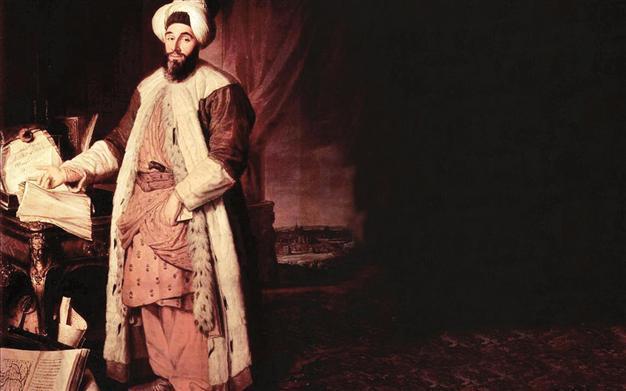The Ottoman five who brought the empire books
Niki Gamm

Yirmisekizzade Mehmed Sait Paşa in Paris, 1742.

İbrahim Müteferrika.
It wasn’t that the Ottomans didn’t know anything about printing presses. After the conquest of Istanbul in 1453, the Jews were granted the right to have a printing press that used Hebrew characters. The Armenians were given approval in 1567 and the Greeks in 1627. It wasn’t just opposition that stalled the introduction – the Ottoman educational system was geared to teaching penmanship as an art. Those who were literate highly valued good calligraphy which took several years of rigorous training before one could receive a certificate of proficiency. Moreover artistic quality was particularly stressed when it came to printing the Quran and other religious books such as commentary.
Printing books in the Arabic language presents some serious problems because when letters are connected, they change form. And since Arabic calligraphy was considered an art form, a number of different scripts had been developed over the centuries – think about documents, books and mosque walls, all in different scripts. Which script to choose for printing was just one of the questions printers faced.
Descriptions of Sultan Ahmed III (r. 1703-1730) and his grand vizier, Nevşehirli Damad İbrahim Paşa (grand vizier 1718-1730) concentrate more on how both men presided over the so-called Tulip Period or Lale Devri (1718-1730) and spent their time on lavish entertainment. Only very recently have scholars decided to look behind the frivolity and have determined that they actually were keenly interested in European developments and applying them in the Ottoman Empire. There is no way that İbrahim Paşa could have carried out changes such as setting up Istanbul’s municipal fire department and supporting the opening of a printing press if he hadn’t had the support of the sultan, who also happened to be his father-in-law. Grand viziers had notoriously short terms in office, even if they were connected with the ruler by marriage.

A document concerning the
Jewish trade in paper. 1766.
İbrahim Müteferrika (1674-1745) was a Hungarian of considerable talent who had converted to Islam. He was acclaimed in many fields ranging from diplomacy to astronomy. The two men got together to set up a printing press for Ottoman Turkish books in Istanbul in spite of serious opposition from religious quarters and calligraphers who expected to be put out of business. Not only did İbrahim Paşa support the project but he also persuaded the Şeyhülislam Abdullah Efendi to go along with it. So on July 5, 1727, an imperial firman was produced that granted permission for the establishment of a press to print books in Ottoman Turkish.
The Müteferrika Press
The going wasn’t easy at first for Müteferrika, not least because he had no skilled labor to draw on. He had to draw on the local Jewish and Armenian printers at first and later brought presses and types from Leiden and Paris. Some specialists were brought from Poland as well as other European centers.
Obtaining paper, however, was something of an obstacle. It either had to be imported from the east, for example, from places like Samarkand or India, or from the west as there were no paper mills in or around Istanbul. While this didn’t bother the Jewish and Armenian printers because their needs were small, it became important for the Müteferrika press because it was the official imperial press.
Müteferrika thought that the mill could be set up in Istanbul’s Kağıthane district through which streams flowed into the Golden Horn from the Belgrade Forest. However, it was concluded that that location wouldn’t do because there might not be and there often wasn’t sufficient water flow during the summer. So the decision was taken to set up the mill in Yalova in 1741.

İbrahim Müteferrika’s map of Indonesia.
According to Galitekin, a Jew named Aslan was sent to Poland where he was entrusted with finding printers willing to come to Istanbul to work. When they arrived, Müteferrika even hosted them in his own home. These men were charged with making whatever machinery they needed in the mill and with teaching Turks how to operate a paper mill and printing press.
In the end – the printing press was closed down in 1742 – 17 books had been printed, the majority in Turkish. The subjects ranged from histories to grammar and tactics. It wasn’t until 1784 that another press printing Ottoman Turkish works was opened.
















